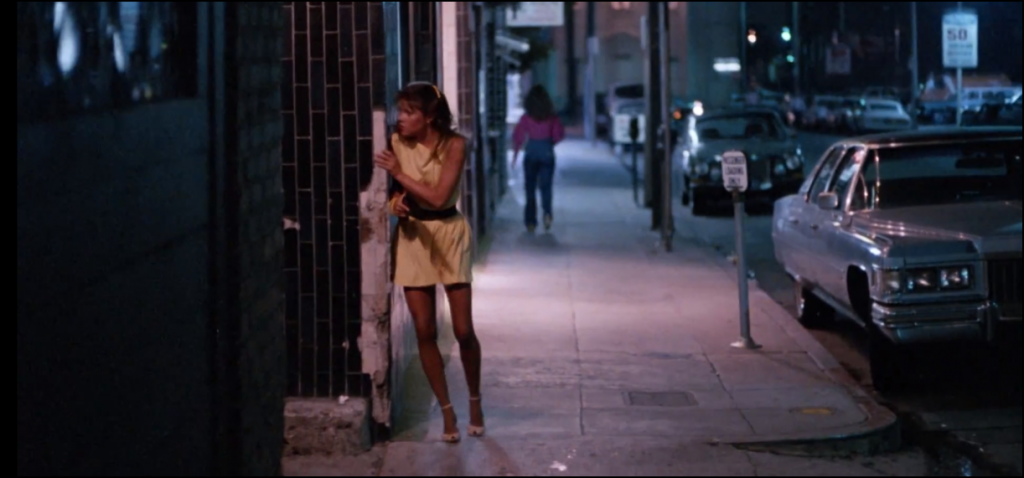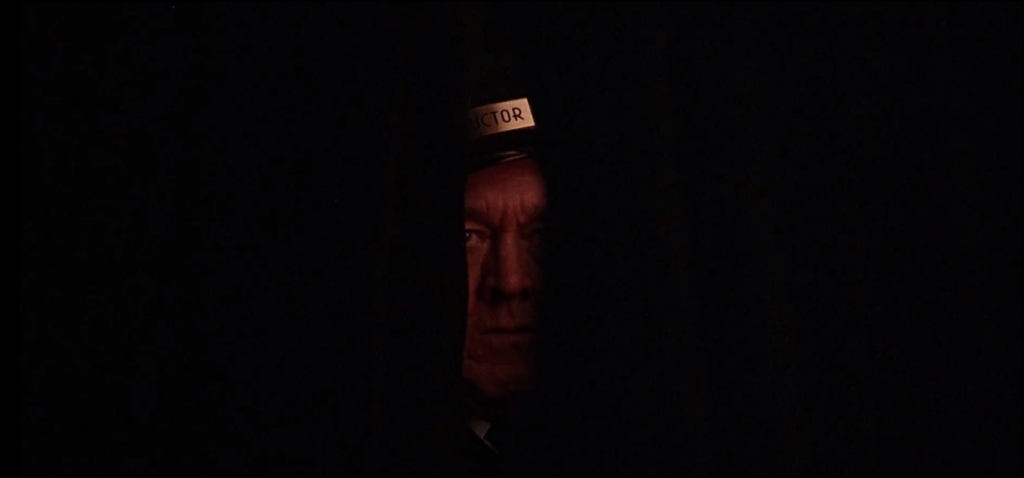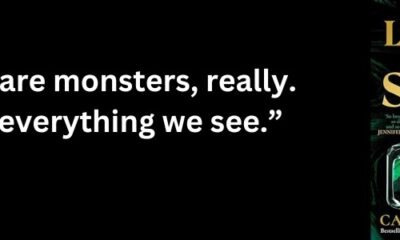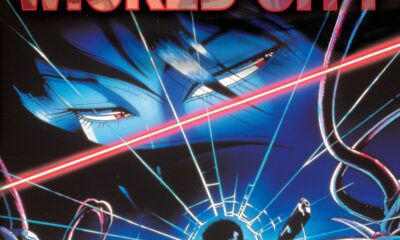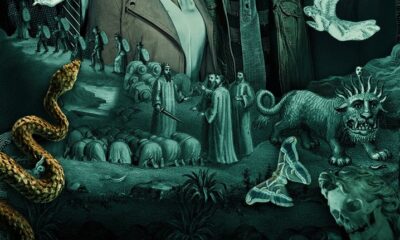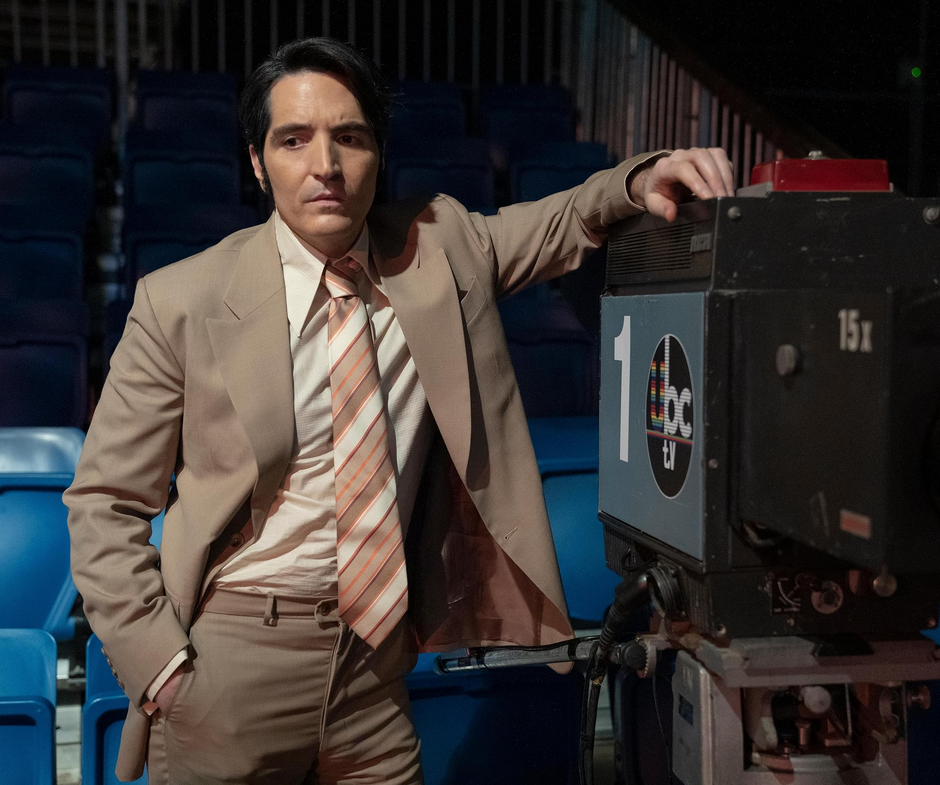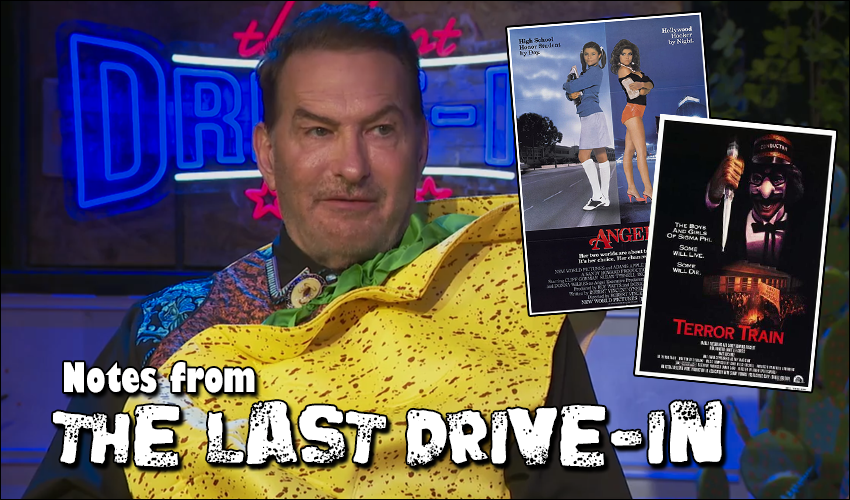
Notes from the Last Drive-In: Halloween Hoedown
More Videos
Published
3 years agoon
Welcome to “Notes from the Last Drive-In,” Haunted MTL’s review and recap series of The Last Drive-In with Joe Bob Briggs on Shudder. This time we cover the “Halloween Hoedown” which brought us 1983’s Angel, and 1980’s Terror Train. We also were given two pretty important guests when it comes to modern horror – director David Gordon Green and mega-producer Jason Blum of Blumhouse Productions. They stopped by the trailer (yay, back at the trailer!) and talked a bit about the upcoming Halloween Kills, horror as a whole, and even joined in on some light Halloween fun.
But, looking at the movie selection – it doesn’t feel very Halloweeny, does it? Let’s get into it, shall we?
Still freaks me out this guy helped bring back Halloween.#thelastdrivein @therealjoebob @kinky_horror @shudder pic.twitter.com/qp8RdE4jug— Haunted MTL 🏳️🌈 (@HauntedMTL) October 9, 2021
Angel (1983)
These characters are all very richly drawn. This movie is fantastic.#thelastdrivein @therealjoebob @kinky_horror @shudder— Haunted MTL 🏳️🌈 (@HauntedMTL) October 9, 2021
Angel (1983) is Roger Vincent O’Neil’s exploitation revenge thriller about teenage Molly, who by day is a sweet honors student, but by night is Angel, a sex worker on the streets of Hollywood Boulevarde, living with an eclectic community of sex workers and outcasts. However, Angel soon finds herself in the midst of a serial killer’s spree who targets people in her line of work.
The movie is not exactly horror but certainly delves into horror themes of predation, loss of innocence, poverty. It is a very tense film and at times it can be absolutely gutwrenching. In lesser hands, the film may have come off as cloying and preachy, but the approach here is excellent and ultimately becomes a rousing story by the final act. It may seem strange to read, but a film about a 15-year-old sex worker is quite an empowering film, arguably feminist to a great degree.
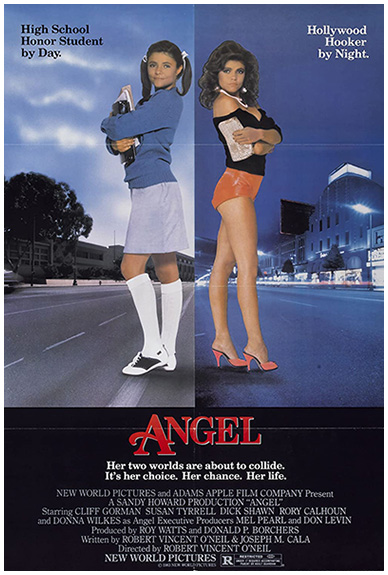
It is the brainchild of Robert Vincent O’Neil who directed and co-wrote the film with Joseph Michael Cala. The film was produced by Donald P. Borchers and distributed by 80s genre-powerhouse New World Pictures. The cast is led by then 21-year old Donna Wilkes playing Molly/Angel, with Dick Shawn, Rory Calhoun, and Susan Tyrell rounding out the oddballs she associates with. Cliff Gorman plays Lieutenant Andrews, the copy who keeps an eye out for Molly, and John Diehl plays the nameless killer.
As a whole, the performances are fantastic across the board. The film uses its veteran and character actors to a great degree of effectiveness. Particularly those in Molly’s street family. Dick Shawn and Susan Tyrell have some utterly fantastic exchanges, and Rory Calhoun, the western veteran, ends up as the coolest gun-slinging street uncle anyone could ask for. Gorman’s portrayal of a hard-working cop is good and actually results in a cop who does good things – though some of his methods may be questionable. It is especially helpful that there is no sign that he wants to help Molly beyond the fact he genuinely is worried about this kid. In a lesser movie, it might play up some sort of cringe-inducing romantic element.
The two performances I would focus on here are Donna Wilkes’ and John Diehl’s. Wilkes is good, even as a relative unknown, to keep up with actors like Shawn, Calhoun, and Tyrell. She is completely charming and does some fantastic emoting with her eyes. Her work as Molly crafts an incredibly sympathetic and strong character. This is especially true as her character changes and grows, becoming the hunter by the film’s final act. Her rich characterization and growth are complemented by John Diehl’s enigmatic and unstable killer who remains unnamed, with only a single line of dialogue after he has been chased down by a 15-year-old girl wielding a revolver in her canary-yellow sundress. True to his skill here, he eats an egg in the most disgusting and horrifying way ever seen and it is a wonderful, stomach-turning bit of characterization.
As for the more technical elements of the film, the cinematography of Andrew Davis is excellent. Using some clever camera tricks and B-roll he manages to really populate the scenes during a time when crowds weren’t as heavy. His photographic eye would serve him well as a director of action thrillers like Under Siege and The Fugitive. Also, he directed Holes, oddly enough. Charles Bornstein’s editing, particularly during the final “chase” of the film is also excellent and combined with Davis’ framing goes a long way toward making the role reversal work.
Also of note, the score by Craig Safan utilized heavy synthesizers and gives the film the aural landscape of the 1980s without diving too deep into what would become the cliche 1980s sound. Even more impressive is that the score was written in less than a week.
Joe Bob-servations
Joe Bob’s observations about the film are about what you would expect: funny and educational. Many of his observations and facts about the production naturally work their way into my review for context. What I want to talk about is a bit of fun during the segments. The prevailing theme of the night was a level of cantankerousness regarding the fandom and the previous Halloween special. It was fun and the grouchy Joe Bob character was quite welcome but also felt a little too defensive at times.
But the main draw of the evening was our venerable host sitting down with David Gordon Green, director of Halloween (2018), and the upcoming Halloween Kills. Green was a great guest for the show, showing his chops when it came to discussing the film. One of the more interesting discussions was on the state of horror, particularly in the streaming world, and what was ahead for David Gordon Green, including an upcoming Hellraiser show.
Final Thoughts on Angel (1983)
Angel was surprisingly good. This was my first time seeing it and I was floored by how complex of a film it was. While I am not sure how well it worked as a Halloween film for a Halloween special, it is definitely a portrait of drive-in excellence. It seems that the series it spawned, of four films, is a case of diminishing returns, but the first movie was so good I wouldn’t mind seeing what happens to Molly going forward. I also didn’t mention this much, but the more progressive streak in the film also proved interesting and worthy of future exploration.

Best Line: “Well, we better get over there before she ends up in the tomb for the unknown hooker.” – Mae
Terror Train (1980)
If David Copperfield doesn't end up as the killer I want a refund.#thelastdrivein @therealjoebob @kinky_horror @shudder— Haunted MTL 🏳️🌈 (@HauntedMTL) October 9, 2021
The more traditionally “Halloween” film of the night was Roger Spottiswoode’s Terror Train – though that is more in spirit than setting as this movie takes place on New Year’s Eve. The film follows a group of pre-med students after a tragic prank three years prior as they board a train for a New Year’s Eve party. Unbeknownst to the partygoers, the consequences of their actions are fast approaching in the form of a mysterious, masked killer.
The film, early enough into the formation of key slasher tropes, is novel enough. It isn’t as meticulously approached as John Carpenter’s Halloween, nor as satirical as The Texas Chainsaw Massacre, not as groundbreaking as Bob Clark’s Black Christmas. However, it is still a very solid slasher with some fun spins on what would become hallmarks of the genre. It also helps that the solid direction of the film by Roger Spottiswoode makes use of the claustrophobic setting quite well. How can a killer move so unimpeded in a commuter train? Spottiswoode does a good job at making the space itself a threat.
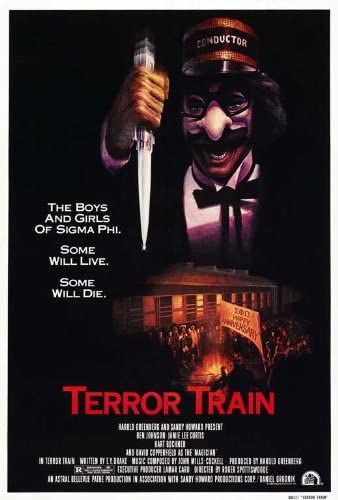
Rounding out the production side of the film, the screenplay was crafted by T. Y. Drake and the overall producer was Harold Greenberg. The movie is a great example of that “Canadian Funny Money” period Joe Bob Briggs has mentioned before – where productions were given heavy tax rebates for shooting in Canada. Terror Train was specially filmed in Montreal during the coldest months of the year, and just after Prom Night had wrapped. It is an independent film, but found a distributor in 20th Century Fox.
As for the performances, the film features Jamie Lee Curtis as Alana Maxwell, who represents the final girl trope quite elegantly. The film also features veteran actor and rodeo cowboy Ben Johnson as Carne, the train’s conductor. Rounding out the cast, are Hart Bochner as “Doc,” Timothy Webber as “Mo,” Sandee Currie, Vanity (yes, that Vanity), and drag artist Derek MacKinnon. Also, for some reason, David Copperfield is in the movie – yes, the magician.
Jamie Lee Curtis is pretty understated here. She doesn’t have quite the type of leading lady role she did in Halloween and Prom Night and the character succeeds as likable through the sheer force of her charisma alone. Derek MacKinnon is interesting, though largely relegated to being disguised. Despite this, MacKinnon chews the scenery pretty well, particularly given the surprising reveal at the climax as to who the killer is. The best performance of the film is from Ben Johnson, but he plays a sort of stock character in over his head and trying to solve a mystery far above his paygrade, but goddamn does he give it his all. Also, David Copperfield does some magic tricks that just feel fake because we’re seeing them in a film. That is why you only see magicians do their craft in person.
Technically speaking, the movie is quite effective and doesn’t feel like a quick cash-in that some might assume. The cinematography of John Alcott is particularly effective given the relatively small spaces on the train. It also helps the effects team were able to make the train seem mobile when it was parked for the entire shoot. If Alcott sounds familiar it is because he was Stanley Kubrick’s most trusted cinematographer, working with him on 2001: A Space Odyssey, A Clockwork Orange, Barry Lyndon, and The Shining. He won an Oscar for Barry Lyndon. One of Alcott’s innovations on the set was to rewire the lighting on the train and use dimmers outside of the train cars to help simulate the movement of a train.
Anne Henderson’s editing is great, giving the film enough angles per scene to give viewers a sense of space. As for the score, I didn’t find the film to have a particularly memorable soundscape. The music is just sort of there.
Joe Bob-servations
Naturally, there was a lot to say on Terror Train, a true slashic, but it seemed the real draw for the night was getting to hear Jason Blum, David Gordon Green, and Joe Bob Briggs talk all things horror, past and present. While Jason Blum’s energy felt a bit too “producer” at times, especially compared to Green and Briggs, his presence was quite insightful. Especially because he is perhaps one of the biggest names in horror production in history, let alone now. It was interesting to hear the trio talk about how movies come about and how modern-day creative partnerships work, and it was also rather reassuring. You get the sense that Blum understands the influence and precariousness of his company and he is quite keen to foster and empower relationships with creators, with Green seeming particularly close. It’s rather pleasant to see.
There was, of course, plenty of talk on Terror Train and classic horror. Particularly fun was the revelation that David Gordon Green’s Frankenhooker t-shirt came from Joe Bob Briggs himself. Green was a fan and sent in for it. An interesting discussion revolved around Green’s education at the University of North Carolina School of the Arts – a smaller school that has provided some great alternative voices in the film industry.
Final Thoughts on Terror Train (1980)
Terror Train is most certainly a classic slasher for a reason. it came out early enough to where the novelty of putting a masked killer in a different scenario or set-up didn’t feel like as big a shortcut as it does now, it had in-her-prime scream queen Jamie Lee Curtis, and did something very interesting with the killer swapping costumes from kill to kill, servicing as a codifier of that trend early on. The film was also fairly progressive in casting a drag performer, Derek MacKinnon, as the killer without necessarily commentating or making a value judgment on drag. It is not the drag that is the problem here, it’s the killing!

Best Line: Alana Maxwell: “No. Kenny, you’re better than he is. I’m sure you’re better than he is.”
Kenny Hampson: “I am. He didn’t know how to cut a woman into pieces.”
Haunted MTL Drive-In Totals
As always, let’s take a look at the official Drive-In Totals:
Angel gets four stars… plus every star on Sunset Boulevard's walk of fame. #TheLastDriveIn pic.twitter.com/Yk8aQfrGNx— Shudder (@Shudder) October 9, 2021 Keep an eye out for that spike to the eyeball. #TheLastDriveIn pic.twitter.com/hAM7zMaIPx— Shudder (@Shudder) October 9, 2021
As for our totals:
- 0 Yuki (rectify this next time, Shudder)
- 2 Street Dads
- 2 Time Horror Hottie
- 2 Guests
- 3 1/2 Minutes of film to shoot with
- Gratuitous Halloween discussion without showing Halloween
- Gratuitous 70s Stage Magic
- Gratuituous Samhain History Lecture
- Gratuitous dissection of the term “microbudget”
- Suprise Drag Night
- Pumpkin Censoring
- Halloween Joking
- Abrubt Ending Fu
- Half-assed Costume Fu
- Joe Bob Fan Club T-Shirt Fu
- Slumber Party Horror Movie Fu
- Krishna Assault Fu
- No Silver Bolo Award!
- Cosplay: Taco Joe Bob, Caultiflower Pizza Darcy, Angel/Molly Darcy

Episode Score
As a whole, the evening was fun but also felt unusually loose in concept compared to other specials. If it weren’t for a couple of the Halloween accouterments and a visit from some of the team behind the upcoming Halloween Kills, you’d be able to mistake this for a general night at the Drive-In. With that being said, an general night on the Drive-In is perfectly fine and if this were a midseason episode it would be great.
So no, Joe Bob, you didn’t “ruin Halloween again,” nor have you ever, but as entertaining as this was there is an expectation of something a little more thematically appropriate. One cannot necessarily fault the fans for thinking so – especially given the guests. All in all, a fun episode with a great double feature – but as far as a Halloween show goes, a little too far outside the margins.

I hope you enjoyed this recap and review of Shudder’s The Last Drive-In with Joe Bob Briggs. We don’t have a date for the return of the show for a full season, but we do know some more specials are on the way. Naturally, we are going to cover them as they release.
In the meantime, please share your thoughts with us about the show, the review, or the movies from the special. We’re dying to hear from you.
This killer seems like a real *groucho* but he is certainly hitting his *marks*#thelastdrivein @therealjoebob @kinky_horror @shudder— Haunted MTL 🏳️🌈 (@HauntedMTL) October 9, 2021
David Davis is a writer, cartoonist, and educator in Southern California with an M.A. in literature and writing studies.

You may like
Movies n TV
Wicked City (1987), a Film Review
Wicked City (1987) is a dark fantasy horror animation following a world at the brink of war as mortals and supernatural being clash.
Published
1 day agoon
October 22, 2024
Wicked City (1987) is a dark fantasy horror and the debut feature-length animation of director Yoshiaki Kawajiri. This unrated film adapts the first novel of the Wicked City series, Black Guard. It stars Yûsaku Yara, Toshiko Fujita and Ichirô Nagai. As of this review, Wicked City is available on Prime and Crunchyroll.
As the peace between the mortal and supernatural worlds ends, forces clash in a plot to establish a new order. Tasked with protecting the best chance for peace, Taki (Yûsaku Yara) must guard Giuseppe Mayart (Ichirô Nagai). A Black Worlder named Makie (Toshiko Fujita) remains his partner in this pursuit. Can the three brave the challenges and establish a world of peace?
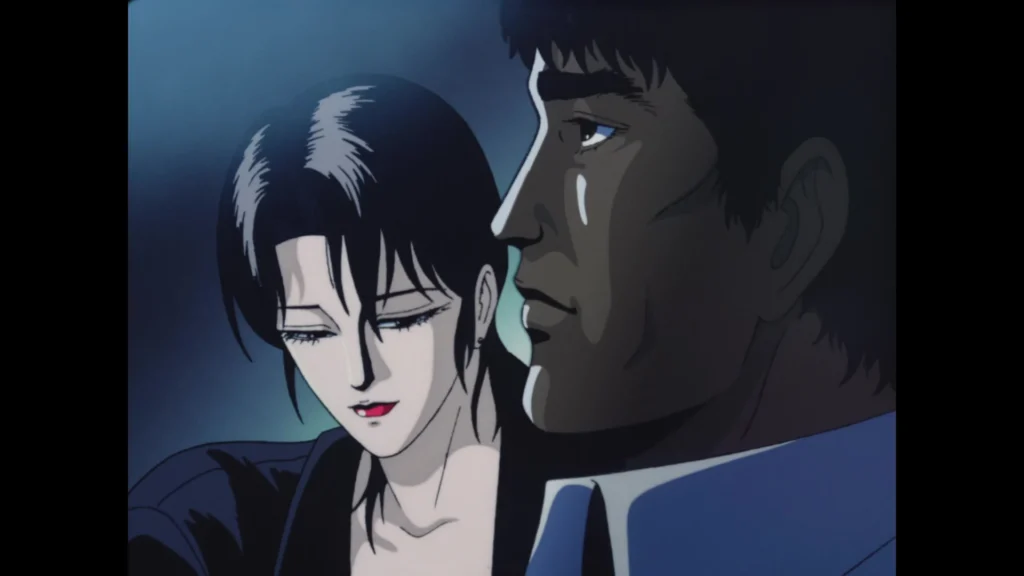
What I Like about Wicked City
Wicked City works best in its parts, providing strong and interesting elements that don’t inherently add up to the whole. The art style and design evoke a memorable aesthetic. There’s a charm to this 80s-era anime that creates either an environment for abominations or spectacles.
It makes sense that Wicked City is an adaptation because the plot depicted seems like parts of a larger narrative we do not see in the film. From what remains, the world and political scheming seem worth exploring. Unfortunately, little of this plot receives depth.
Prior to this, Yoshiaki Kawajiri contributed to many TV shows, exercising a new muscle as he directed a film-length work. He seems invaluable on a team, as his filmography and success indicate, but his directorial contributions don’t seem as critically successful. This effort and work best express themselves in the level of animation and scenes depicted in this flawed film.
Despite the missing pieces throughout the film, the ending seems complete. While there’s clearly room for a sequel, Wicked City tells its story and suggests an answer to the new era’s direction.
Supposedly, this started out as a short film, but Yoshiaki Kawajiri’s execution earned enough attention and respect to get a green light for a feature-length film. This work was all done within a year. Assuming this is true, Wicked City’s completion and animation quality deserve respect.
It received a live-action adaptation. From my understanding, the film adapts the anime, but I hope and imagine some of the manga gets explored to make a more functioning plot.

Tired Tropes and Triggers
Sexual assault and rape remain grotesquely overused in the film. Such subject matter has a place in art, but its use in Wicked City gravitates more toward exploitation and spectacle. Many of the visual designs make most of the fight allegories for sexual assault atop the actual assaults.
As most creatures are organic, there’s a heightened amount of body horror. There’s a level of separation in animation as opposed to live-action body horror, but this point certainly applies to those sensitive to such material.
From what we learn of the characters, many decisions directly contradict their supposed purpose.
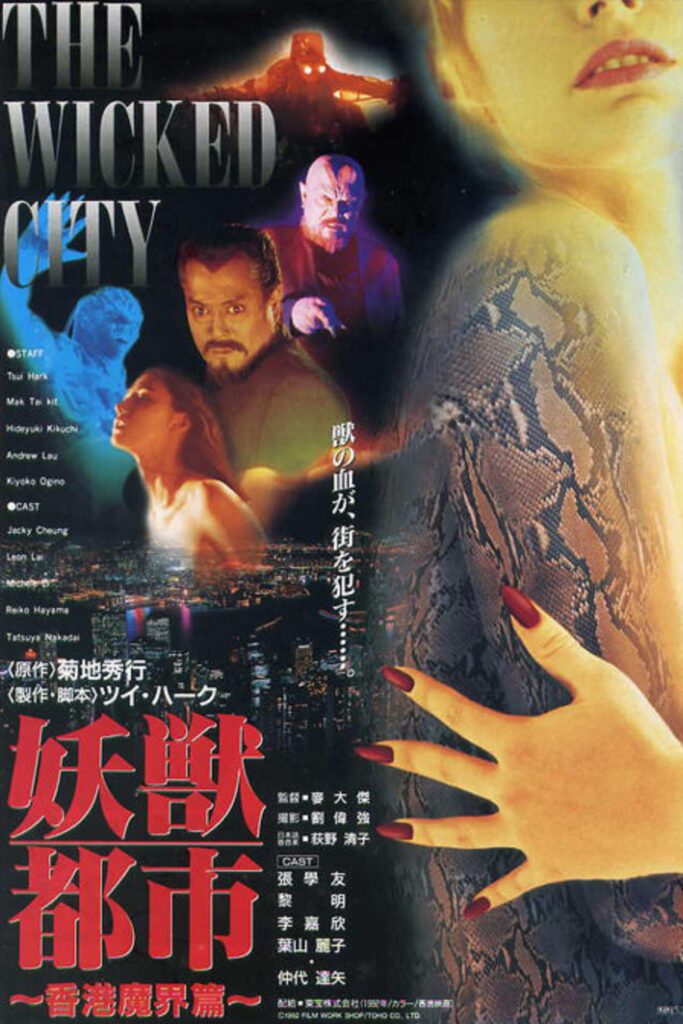
What I Dislike about Wicked City
Wicked City circles forums and rank-listings as a cult classic or niche horror, but it’s flawed in almost every way. Ideally, such works might have a plot that draws one in. Wicked City has a concept of a plot that evokes interest but doesn’t communicate it well or explore its depths. Ultimately, it’s a film made up of its parts. The good gets outweighed by the dysfunctional points.
Frankly, the romantic tension between the two leads is underdeveloped. I hesitate to say it doesn’t exist because there’s some work implemented with this in mind. Viewers note the work in the film, but it lacks polish or sensibility.
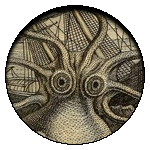
Final Thoughts
Wicked City is a flawed work from a successful animator. If given more time to develop, perhaps a staple of the 80s might exist. Unfortunately, the film has merits in its parts but falls in connection to the whole. However, for those who can overlook the limitations and exploitations, there are many worthy parts that excel in terms of animation quality and creative decisions.
Released in 2023, Late Night with the Devil is a found-footage movie about a late-night host who’d do anything to have the top-rated show.
Don’t worry, it’s not about Jay Leno.
The story
Our story begins, as many found footage films do, with a quick explanation. What we are going to see is the surviving footage from the last episode of a late-night show, along with some never-before-seen footage of backstage during the fateful night everything went wrong.
We then meet Jack Delroy. He’s a late-night host of the show Night Owls. And a year after the death of his beloved wife, he worries that his show is going to be canceled. The ratings are freefalling. So, on Halloween, he invites a girl named Lilly on the show who claims to be possessed.
Because that’s going to go well.
The show begins with a monolog, like most late-night shows. We then meet the first two guests, a claimed psychic named Christou and a stage magician slash skeptic named Carmichael Haig. After hot-reading the audience, Christou appears to have a real psychic vision. One that involves Jack’s deceased wife. He then proceeds to vomit black sludge all over the stage.
You’d think that would be the end of things. It would be stupid to still bring on the possessed girl after a warning like that.
But, of course, the show must go on.
What worked
Late Night with The Devil dedicated itself to the found footage vibe. As such, it felt very much like you were watching something from the 70s. The whole movie is at a lower, grainy resolution, unlike some other horror films that eventually and subtly switch out for a more modern and clear picture. The clothes, the music, the cheap and cheesy costumes. It all reminds one of a good episode of the Brady Bunch or Bewitched. Even when someone’s puking black blood or has worms pouring out of their freshly opened gut.
I was also quite impressed by the acting in this film. Especially that of David Dastmalchian, who played Jack Delroy. This role was performed to perfection. Jack manages to come off as a kind, compassionate man. The sort of person you’d be comfortable talking to, even about the most horrible moments of your life. You get the feeling that you could tell him about the worst moments of your life and he’d thank you for sharing.
This kind facade never slips. But we also see his true motivations. He doesn’t care about anyone, no matter how kind he acts. The show must go on is his entire drive and mission. He didn’t let a little thing like a guest dying stop him. Or a mental breakdown on stage. Or even his dead wife calling to him from beyond the grave.
The show must go on. And on, and on.
Even Dastmalchian is outshined, however, by Ingrid Torelli who played Lilly.
Lilly was a creepy character from the first time we saw her. There is something so unnerving about a child who knows far more than they should. This is a hallmark of demon possession films, all the way back to Reagan. But there’s also something else about the way she behaves that has little to do with the possession. She is always looking to either June or Jack for direction. As much as she speaks to the adults like she knows one, she is still always looking to please the adults around her. She is eager to look at the right camera at the right moment. She is eager to be obedient. It’s hidden, but for someone who has seen enough cult content, it’s easy to spot. She played a former cult victim very well. And that was perhaps the most terrifying part of that character.

What didn’t work
This was almost a perfect movie. Then, like so many others, it just couldn’t stick the landing.
Near the end of the film, there is a strange scene that doesn’t seem to mesh with the rest of it. It appears to be a collection of Jack’s memories. Whether they are true memories or not is left to our interpretation. But they explain the entire reveal of the whole movie. In dull, excruciating detail.
This series of scenes was insulting. It was the equivalent of asking someone if they got the joke. But are you sure you got it? Wait, let me explain it and really just kill the effect altogether.
We were already laughing. Or, to step away from this metaphor, we were already creeped out. We were already grossed out. We were already living in the scene, sitting in the audience right next to the lady who lost her son or the man dressed as a skeleton. Rather than explain the twist, which didn’t need explaining, this scene pulls us rudely out of that audience and deposits us back in the real world.
All that being said, Late Night with The Devil is still a terrific horror film. It was dark, it was gorey, and it left us with unsettling questions even after the ill-planned info dump. If it isn’t already on your Halloween watch list, it certainly deserves a spot.

Movies n TV
“B is for Brain” (Evil: S2E8)
“B is for Brain” is an episode of the supernatural drama Evil. The assessors investigate new brain mapping research.
Published
2 days agoon
October 21, 2024
“B is for Brain” is an episode of the supernatural drama Evil, created by Michelle King and Robert King. The central cast includes Katja Herbers, Mike Colter, Aasif Mandvi, Michael Emerson, Christine Lahti, and Andrea Martin. It originally aired under CBS before moving to Paramount+. As of this review, it’s available through Netflix and Paramount+ and its add-ons.
The assessors investigate new brain mapping research that might expose others to God and Hell. Kristen (Katja Herbers) struggles with aggression as Andy (Patrick Brammall) returns from his expedition. Ben (Aasif Mandvi) struggles with what he sees while in the brain mapping process. David (Mike Colter) returns to the basics to find God.
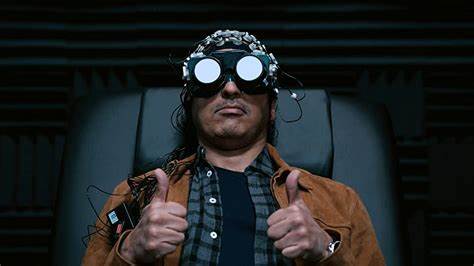
What I Like about “B is for Brain”
“B is for Brain” provides a unique opportunity for viewers to gain more insight into Ben’s past. While not his episode, as “B is for Brain” balances the leads nearly perfectly, he has his most emotional moment in the series so far. Despite the lower stakes, it provides a more vulnerable moment than “E is for Elevator.”
Leland (Michael Emerson) and Sister Andrea (Andrea Martin) meet again on more equal terms and establish their hostile relationship. Sister Andrea proves herself to be a woman who doesn’t back down when a Satanist tries to intimidate her. It also raises the necessity of David’s training, creating a more tangible threat.
Kristen’s deteriorating relationship with Andy reaches a boiling point as her impulsiveness and hostility reach new heights. It seems her sabbatical to the monastery might have increased the evil influences. “B is for Brain” builds upon what “S is for Silence” introduces and creates an interesting interpretation of the last episode’s events.
“B is for Brain” brings a new dynamic to its horror by focusing on how technology, science, and religion intersect. There’s an incredibly diabolical conversation on how this technology could induce fear to empower religion. This idea evokes a more subtle horror than most episodes.

Tired Tropes and Triggers
There is a potential nay-theist trope. By that, I mean there’s a single line where one can interpret an atheist character turned from God because God turned from them. It’s a single line that remains interpretable, but it’s worth mentioning.
There’s a moment of self-harm with clear implications that this is a pattern with the specific character. This harm has some implication of demonic influence, but this remains unconfirmed at the moment. I will mention this becomes more obvious as the season continues.
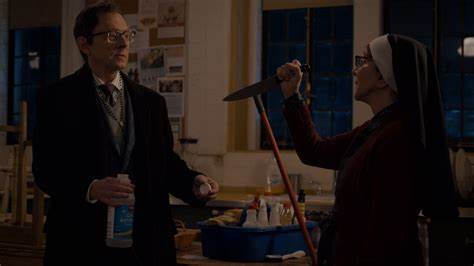
What I Dislike about “B is for Brain”
Unfortunately, such a big reveal for Ben’s character doesn’t have time to get fully explored in “B is for Brain.” While the focus between the three is great, a few big reveals only earn a light address. It’s less that Ben doesn’t get a fair amount of attention and more that these subjects don’t receive that attention.
A similar point remains relevant about the claim of using brain mapping as a way of evoking religious conversion. That point merits interrogation from the characters and the plot, but it’s only lightly touched on. Further expanding these points is that there’s only light reference in the future specifically about brain mapping.

Final Thoughts
“B is for Brain” gets placed into two memorable episodes, diminishing its lasting power. While not a fault of the episode, it does overlook some potentially big reveals. Some of the more relevant character moments will receive the attention they deserve in later episodes, but it doesn’t aid “B is for Brain” in execution. While a strong and enjoyable episode, diving into those moments might have created an episode that haunts the viewer.

